16 Strings Attached
| May 10, 2022Tzitzis making 101 at Camp Yoreh Deah
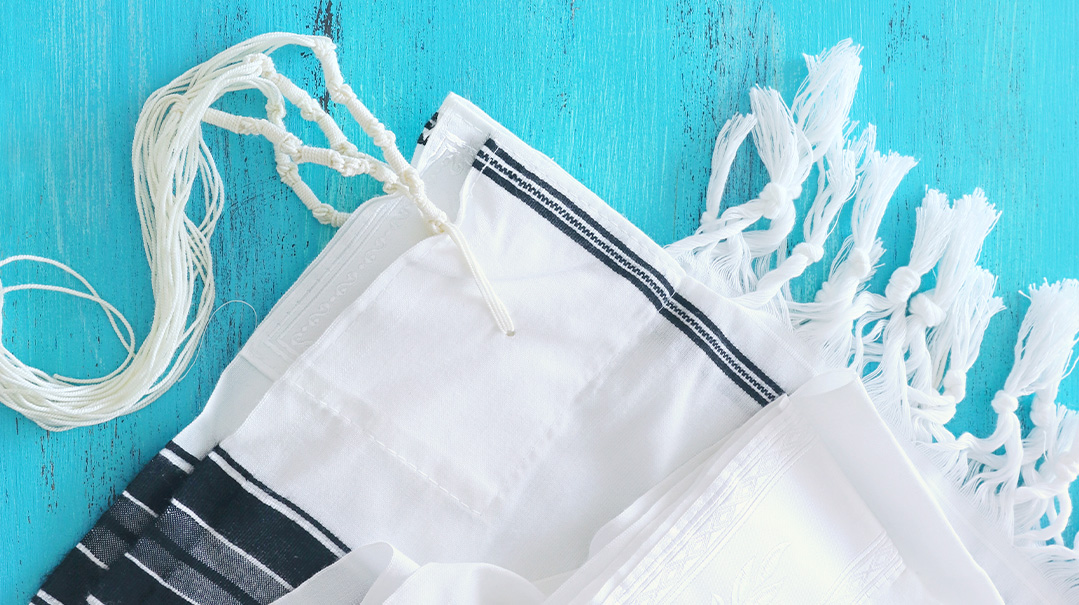
Photos: Camp Yoreh Deah
You might know a cute little three-year-old who’s about to get his hair cut on Lag B’omer. And when he gets his hair cut, he’ll start wearing tzitzis too. Did you ever wonder what it takes to make a pair of tzitzis?
We met up with Rabbi Chaim Kirschbaum, the programming director at Camp Yoreh Deah, where the boys learn all kinds of halachic processes, and he told us how the boys learned to make tzitzis from the very first step to the last.
Step 1:
Catch a Sheep
According to halachah, the strings on tzitzis can either be made of wool (from sheep) or linen. Nowadays everyone makes the strings from wool — so it’s time to find a sheep.
Luckily for the campers at Camp Yoreh Deah, they have lots of animals on the grounds. The boys enter the sheep pen and choose a nice fat sheep. The sheep aren’t so excited to have the boys there, Rabbi K. explains, but once you get your hands on a sheep, they’re usually pretty accommodating.
“All winter long, Hashem makes the sheep’s hair grow longer and longer, so that he has a nice warm coat. Come summer, some sheep shed their hair, but others need the farmer to shear them. Then the big, fat sheep become skinny, scrawny sheep,” he explains.
There’s just one problem. To get the longest wool, for nice, long tzitzis strings, you need to shave the sheep at the end of the winter. But camp is in the summer, when the sheep’s wool is already short. In Camp Yoreh Deah, the boys sheer a sheep just to see what it’s like. To actually make the tzitzis, though, they use long wool that was shorn at the end of the winter.
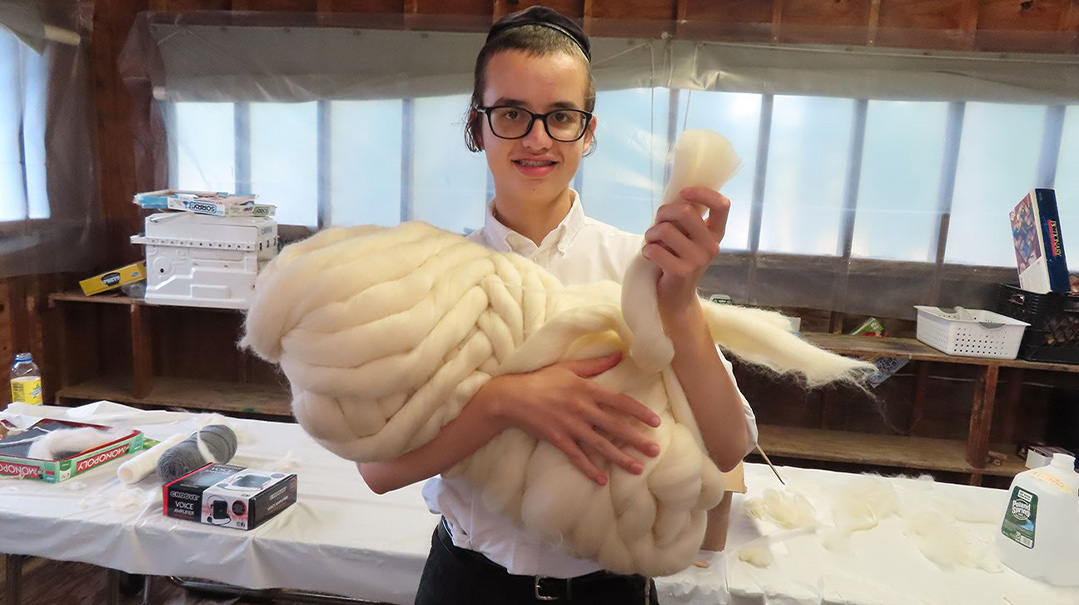
Washing and Combing
After you get the wool, it needs to be washed and combed. You would never do that on Shabbos because those are the melachos of melabein and menapeitz.
Melabein — washing the wool
Menapeitz — combing
Lumps of wool are placed on big blocks of wood with little metal teeth sticking out. These are called minarets “combing cards.” The camp owns a few sets of combing cards, which the boys rub back and forth against each other to get all the fibers smooth and going in the right direction.
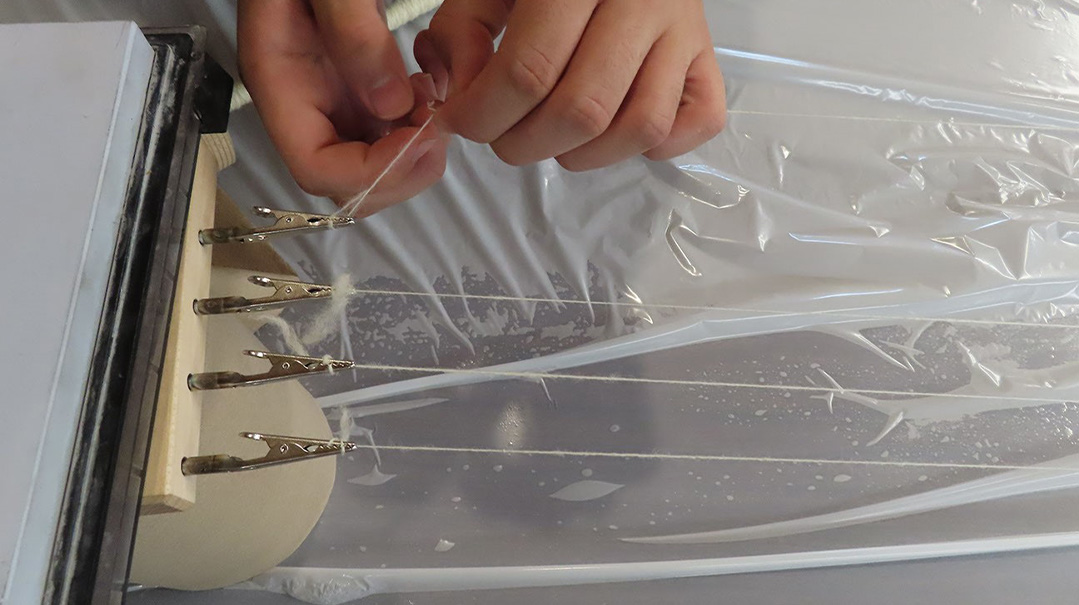
Spinning the Wool
Tviyah — spinning
The hardest part of the process is the tviyah — spinning. “Once upon a time, this was a job every mommy did,” says Rabbi K. “You know those old pictures you sometimes see in old books, of a spinning wheel? We use something much simpler, called a spindle or a drop spindle. Once you practice a lot, it’s easy, but it takes a lot of practice. You have to spin the wool with just the right amount of tension; too loose and your yarn won’t be strong enough, but too tight, and the yarn breaks.
“All the boys in camp get a turn to try doing the tviyah so they know exactly what it’s like. But since it’s so hard, no one gets it right the first time. It can be very frustrating. There’re a lot of broken threads when the boys try out the spindles — and a lot of laughter. They’re good sports about it. Lots of boys made great threads, but a pair of tzitzis needs about 40 feet (12 meters) of string!”
“Only 5 out of about 70 boys were able to spin enough yarn to make themselves a pair of tzitzis. For everyone else, we brought in enough ready-made string for the boys to make their tzitzis.”
Just in Time
“Yanky” was extremely motivated to make his own tzitzis,” Rabbi K. related. “He kept trying to spin the wool and got better and better at it. Wherever Yanky was, his spindle was with him, and of course puffs of wool, too. After lots and lots of work Yanky finally had it; more than a hundred feet of thread painstakingly and lovingly spun l’sheim mitzvas tzitzis.
“Now came time for shizur — plying — still a delicate task, but much simpler than spinning. Yanky found a partner and together they stretched out the long strings and started to twist. Careful! Don’t let go! No, now it’s too tight and the string is bunching up….
Finally, after all this work, Yanky had enough string spun and plied, lishmah; just enough, not a drop extra. Yanky had to cut each long string into four as each corner needs four double strings, but he was afraid that he might cut it the wrong size and ruin his precious, almost irreplaceable kosher string, so instead of cutting it, Yanky poked the long string through the corner once, twice, again, and then a fourth time. He carefully adjusted the string till It was perfectly ready to become four strings and then he just snipped it at the bottom, turning it into four strings.
Hashem was watching him and made sure someone caught him in time. Yanky had just missed a very important halachah and was about to make his precious tzitzis passul. There’s a halachah called Taseh v’lo min ha’asui. You must put the tzitzis in the beged when they are already kosher. You can’t stick in nonkosher strings and only make it kosher afterward. Yanky’s string was one long string when he put it in; it only became four later, when he snipped it. That’s not kosher. Luckily, Yanky’s mistake was caught in time. Yanky removed his four strings and put them back in now that they were kosher. And of course, he didn’t forget to say “l’sheim mitzvas tzitzis!”
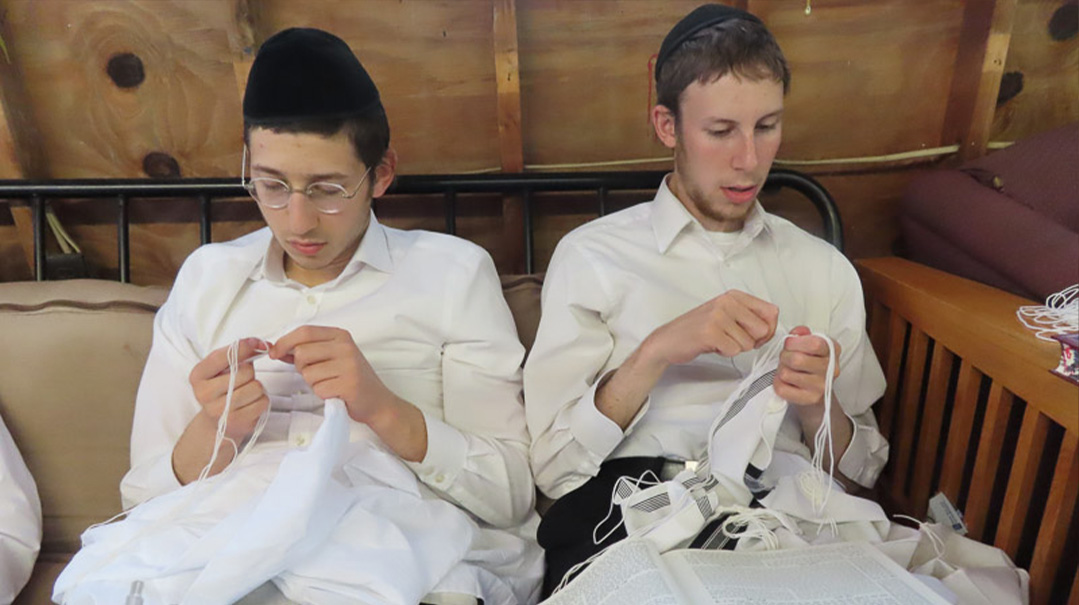
4 strings x 4 corners x 2.5-3 feet each string = 40-48 feet (12-14 meters). Each string also must be shazur — plyed — so that’s at least x 2. Which means you need at least 80 feet (24 meters) of thread per pair!
There’s a very important halachah related to the tviyah. When someone is making strings for tzitzis, they have to make it lishmah. That means that they have in mind that the strings are being made to use for the mitzvah of tzitzis. In the times of the Gemara, the woman running the spinning wheel would say “l’sheim mitzvas tzitzis.” It’s a hiddur to say that the strings are for the mitzvah of tzitzis from the time of the combing.
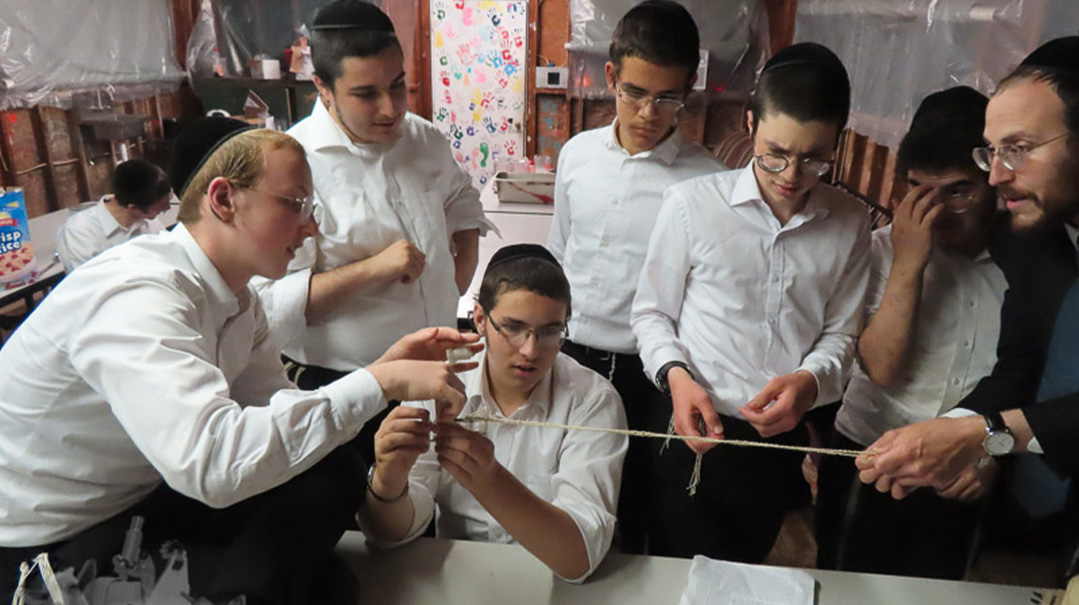
Shizur — plying
If you take a very close look at one of the strings of tzitzis, you’ll see it’s really a lot of threads twisted together to make a strand.
Each string of tzitzis is made of eight thinner threads. To get the strands to hold together, they have to each be twisted very tightly in one direction and then twisted together in the opposite direction while they’re held very tightly.
If you’ve ever twisted strings together, you know that when you let go, they unravel. But plying works like this: Let’s say you twist two sets of four strings very tightly in one direction, and then you take those two sets, and while still holding them tightly so they don’t unravel, you twist the two sets together. When you let go, they will try to unravel, but because they’re twisted together, they unravel into each other, making a very strong thread. That’s how every single string of tzitzis is made!
There’s a tool that’s usually used to make fringes on tablecloths and flags and things like that, that helps you twist all the strands together to make one strong string. “Do you know what the tool is called?” Rabbi K. remarks. “It’s called a fringe twister — isn’t that a very original name? The camp has lots of these tools, and each boy gets to practice doing shizur.”
Remember what we said before about needing to keep saying “l’sheim mitzvas tzitzis”? The boys practice doing shizur on lots of regular string to get it right. The only difference between the string they practice on and the kosher string that they’re going to use to make their own tzitzis is that no one said it was special for tzitzis. Pretty cool that having in mind that the strings are for the mitzvah is such a crucial part of the process, isn’t it?
When the boys have their strings made (the kosher kind), some of the strings can be very long and have to be cut. Just like the Mizbeiach, which could not be made using metal tools, tzitzis strings cannot be cut with metal scissors. This is because metal is used for war, which shortens people’s lives, so it’s not appropriate to use it for the Mizbeiach or tzitzis, which make a person’s life longer. The camp has special scissors with a ceramic blade, but there’s a specific inyan to use your teeth to cut the strings. This is related to the fact that the mouth has 32 teeth just as a beged has 32 strings of tzitzis (4 corners x 8 strings = 32 strings).
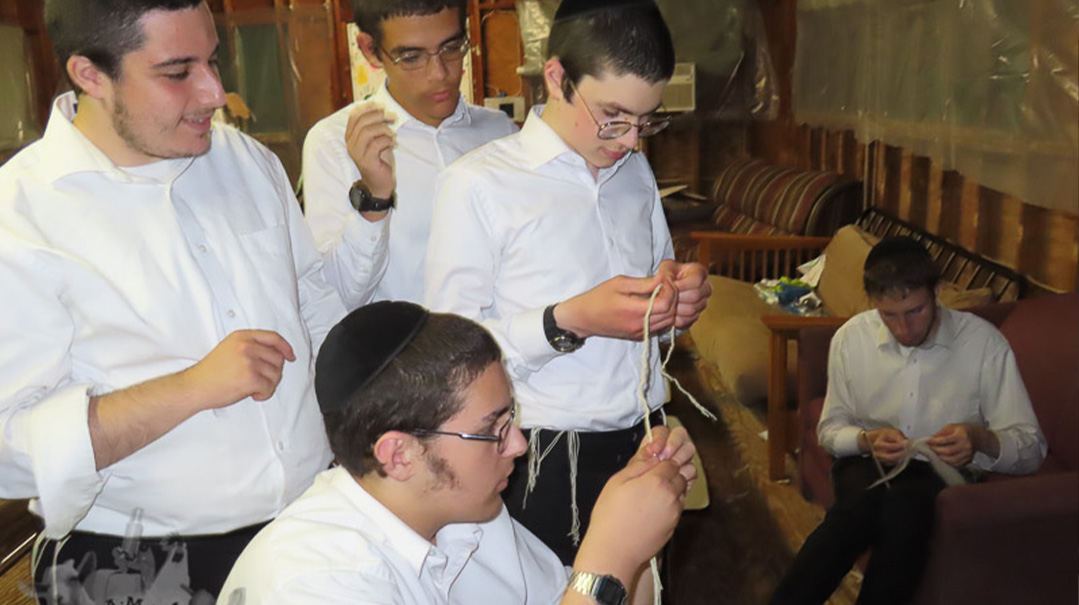
Threading the String through the Beged
After all that work, it’s finally time to make the tzitzis. Each boy gets a beged — a four-cornered garment with four holes in the corners. The hole has to be just right, not too close to the edge and not too far from the edge, and it has to be reinforced, so that it won’t tear.
Each boy threads his four strings through the hole (tzitzis are made with eight strings — so when you thread one string through the hole, there’s now part of the string on each side, so it’s like two strings). It’s very important to remember to say “l’sheim mitzvas tzitzis” as you thread them through the hole, or else they won’t be kosher! One string is left much longer than all the others, so that it can be wrapped around the other strings in between the knots.
There are different minhagim about how many knots to make and how many times to wind the string, but mi’d’Oraisa each set of strings only needs two double knots and string wrapped around three times in between.
The camp follows the most common minhag when teaching the boys how to tie their tzitzis, which is five double knots with the string wrapped around between each set of knots seven, eight, eleven, and thirteen times, respectively. (There are a lot of deep and special reasons for the number of knots and how many times you wrap the strings.)
Voilà! Each boy has his very own pair of tzitzis that he made himself. It’s a whole different feeling keeping a mitzvah when you know what went into it every step of the way. You know just how precious your tzitzis are.
(Originally featured in Mishpacha Jr., Issue 910)
Oops! We could not locate your form.






